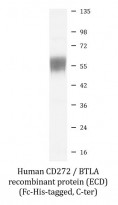ARG70309
Human CD272 / BTLA recombinant protein (ECD) (Fc-His-tagged, C-ter)
Human CD272 / BTLA recombinant protein (ECD) (Fc-His-tagged, C-ter) for Binding Activity,SDS-PAGE and Human
Overview
| Product Description | HEK293 expressed, Fc-His-tagged (C-ter) Human CD272 / BTLA recombinant protein (ECD). |
|---|---|
| Tested Reactivity | Hu |
| Tested Application | Binding, SDS-PAGE |
| Target Name | CD272 / BTLA (ECD) |
| Species | Human |
| A.A. Sequence | Lys31 - Thr134 of Human CD272 / BTLA (NP_001078826.1) with an Fc-6X His tag at the C-terminus. |
| Expression System | HEK293 |
| Alternate Names | CD antigen CD272; BTLA1; B- and T-lymphocyte-associated protein; B- and T-lymphocyte attenuator; CD272 |
Application Instructions
| Application Note | Binding activity test: Measured by its binding ability in a functional ELISA. Immobilized Recombinant human BTLA at 3µg/ml (100 µl/well) can bind Biotinylated Recombinant human HVEM with a linear range of 18-72 ng/ml. |
|---|
Properties
| Form | Powder |
|---|---|
| Purification Note | 0.22 µm filter sterilized. Endotoxin level is <0.1 EU/µg of the protein, as determined by the LAL test. |
| Purity | >90% (by SDS-PAGE) |
| Buffer | PBS (pH 7.4) |
| Reconstitution | Reconstitute to a concentration of 0.1 - 0.5 mg/ml in sterile distilled water. |
| Storage Instruction | For long term, lyophilized protein should be stored at -20°C or -80°C. After reconstitution, aliquot and store at -20°C for up to one month, at 2-8°C for up to one week. Storage in frost free freezers is not recommended. Avoid repeated freeze/thaw cycles. Suggest spin the vial prior to opening. |
| Note | For laboratory research only, not for drug, diagnostic or other use. |
Bioinformation
| Gene Symbol | BTLA |
|---|---|
| Gene Full Name | B and T lymphocyte associated |
| Background | This gene encodes a member of the immunoglobulin superfamily. The encoded protein contains a single immunoglobulin (Ig) domain and is a receptor that relays inhibitory signals to suppress the immune response. Alternative splicing results in multiple transcript variants. Polymorphisms in this gene have been associated with an increased risk of rheumatoid arthritis. [provided by RefSeq, Aug 2011] |
| Function | Inhibitory receptor on lymphocytes that negatively regulates antigen receptor signaling via PTPN6/SHP-1 and PTPN11/SHP-2 (PubMed:12796776, PubMed:14652006, PubMed:15568026, PubMed:18193050). May interact in cis (on the same cell) or in trans (on other cells) with TNFRSF14 (PubMed:19915044). In cis interactions, appears to play an immune regulatory role inhibiting in trans interactions in naive T cells to maintain a resting state. In trans interactions, can predominate during adaptive immune response to provide survival signals to effector T cells (PubMed:19915044). [UniProt] |
| Cellular Localization | Membrane; Single-pass type I membrane protein. [UniProt] |
| Calculated MW | 33 kDa |
| PTM | Phosphorylated on Tyr residues by TNFRSF14 and by antigen receptors cross-linking, both inducing association with PTPN6 and PTPN11. N-glycosylated. [UniProt] |
Images (1) Click the Picture to Zoom In






